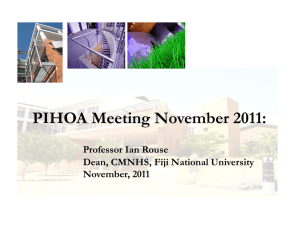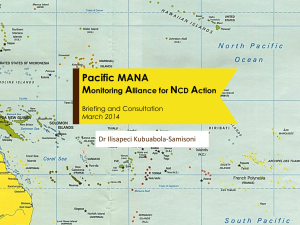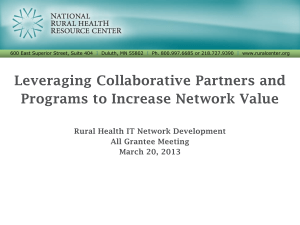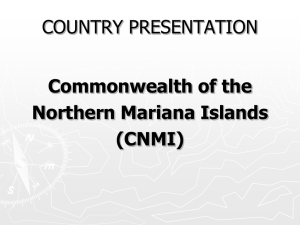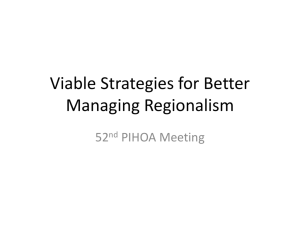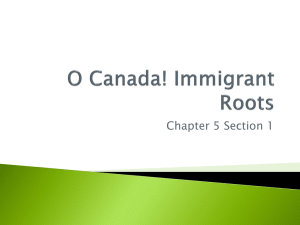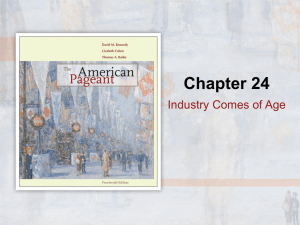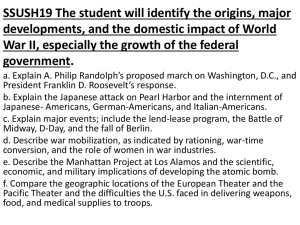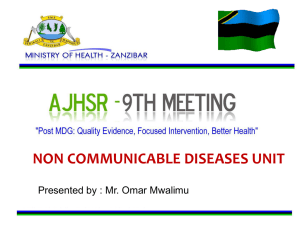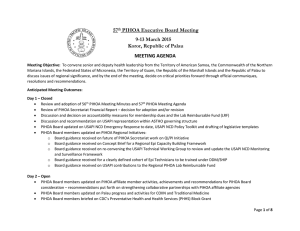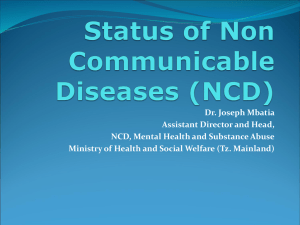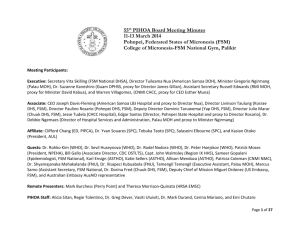Overview of PIHOA 3.89 MB
advertisement
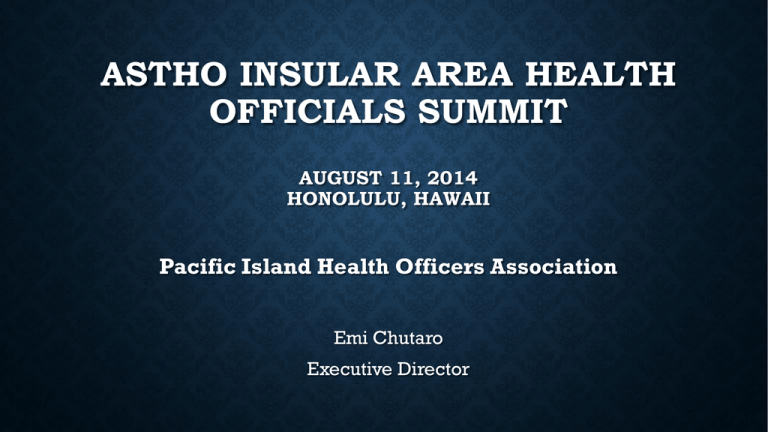
ASTHO INSULAR AREA HEALTH OFFICIALS SUMMIT AUGUST 11, 2014 HONOLULU, HAWAII Pacific Island Health Officers Association Emi Chutaro Executive Director PACIFIC ISLAND HEALTH OFFICERS ASSOCIATION (PIHOA) • Established in 1986 by Pacific health officials – regional voice for the six USaffiliated Pacific island countries and territories • Non-profit 501(c)3 – chartered in the CNMI and the State of Hawaii • 3 offices – Honolulu (HQ), Guam and Palau; 1 staff currently on extended onsite assignment to American Samoa • 8 staff and 3 contract retainers; hosting 2 regional CDC Immunization staff (with plans for 2 more from CDC Chronic Disease and Preparedness) • Funding sources: CDC, CDC ASTHO, HRSA and membership dues PIHOA BOARD MEMBERSHIP Executive Members – voting members 1. President - Dr. Vita Skilling, Secretary of Health, FSM National DHSA 2. Vice-President – Motusa Tuileama Nua, Director of Health, American Samoa DOH 3. Mr. Jim Gillan, Director of Health and Social Services, Guam DPHSS 4. Mrs. Esther Muna, Chief Executive Officer, CNMI CHCC 5. Mr. Gregorio Ngirmang, Minister of Health, Palau MOH 6. Mr. Philip Muller, Minister of Health, Marshall Islands MOH PIHOA BOARD ASSOCIATE MEMBERS 1. Dr. Livinson Taulung, Director of Kosrae Health Services, FSM 2. Mr. Paulino Rosario, Director of Pohnpei Health Services, FSM 3. Mr. Julio Marar, Director of Chuuk Health Services, FSM 4. Mr. James Gilmar, Director of Yap Health Services, FSM 5. Mrs. Julia Alfred, Secretary of Health, RMI 6. Mr. Joe Verga, CEO, Guam Memorial Hospital 7. Mr. Joseph Fleming, CEO, American Samoa LBJ Hospital 8. Dr. Debbie Ngemaes, Director of Hospital Services and Administration, Belau Hospital 9. Ms. Berry-Moon Watson, Director of Public Health, Palau MOH PIHOA BOARD AFFILIATE MEMBERS 1. American Pacific Nursing Leaders Council (APNLC) 2. Cancer Coalition of the Pacific Islands (CCPI) 3. Secretariat of the Pacific Community (SPC) 4. Association of USAPI Labs (AUL) 5. Pacific Resources for Education and Learning (PREL) 6. Pacific Basin Medical Association (PBMA) 7. Pacific Basin Dental Association (PBDA) 8. Pacific Islands Primary Care Association (PIPCA) 9. Pacific Basin Behavioral Health Collaborating Council (PHBCC) 10. Pacific Post-Secondary Education Council (PPSEC) CURRENT IMPLEMENTATION PARTNERS • WHO and SPC • USAPI health agencies • UH JABSOM and School of Nursing, UoG and FNU CMNHS • Local colleges – CMI, COM, PCC, ASCC and NMC • ASTHO • APHL and DLS (Hawaii and Guam) BOARD MANDATES • Promote improved health practices • Provide a forum for the exchange of information and knowledge • Be a vital link/network between and among visiting medical and health professionals • Promote health-related research beneficial to the welfare of the people of the Pacific • Increase the knowledge and practice of public health in the region by promoting high professional and medical education standards • Foster and support other organizations that have similar public health purposes and objectives • Research on funding mechanisms to maximize the quality and quantity of health services available to the Pacific • Foster regional efforts in providing appropriate means of improving the accessibility, quality and cost-effective delivery of healthcare services to the address the needs of Pacific communities STRATEGIC PLAN 2013-17 OUTCOMES • Outcome 1 – Demonstrated political leadership at the highest level to take responsibility for and address health at national and regional levels • Outcome 2 – Have ensured appropriately adapted, contextualized and relevant multi-sectorial policy environment to mainstream health responses • Outcome 3 – Priority cost-effective and evidence-based interventions with appropriately set performance monitoring frameworks, including research and surveillance efforts, are supported and strengthened • Outcome 4 – Have ensured that priority public health responses are adequately resourced and sustainable, including appropriate and relevant human resources, infrastructure, financial resources and technical assistance • Outcome 5 – Have ensured accountability of all sectors, including pertinent non-health sectors, for their respective contributions to stated health priorities • Outcome 6 – Strengthened advocacy and community engagement in health • Outcome 7 – Strengthened health systems to effectively respond to health priorities SCOPE OF WORK 2013-17 Ancillary and Support Services Health Information Management Systems (HIMS) Performance Improvement Human Resources for Health (HRH) Strategic Planning and Engagement Policy Development ANCILLARY AND SUPPORT SERVICES • TA and consultation on laboratory system improvement process for Level I and II labs • Improvement of influenza lab-based surveillance and other infectious diseases • Strengthening specimen shipping networks, including diagnostic referrals and IATA certification (Specimen Referral Revolving Fund) • Consultation and TA to strengthen local lab potential and accreditation, including LQMS • Communication and networking with regional USAPI lab networks, including local health agencies and regional partners (CDC, WHO and SPC) PERFORMANCE IMPROVEMENT AND HIMS • Strengthen QA & QI programs in local health agencies – design and implement QI projects / develop policies and procedures • Building Quality & Performance Communities of Practice through workshops, conference calls, listserv (pacificqualnet@googlegroups.com), and cross-jurisdiction attachments • Development, dissemination and mentoring for local college QI certificate curriculum • Rapid performance and quality program assessments • Assistance to health officials to identify performance indicators that match agency priorities, develop data definitions and methods for collection, assemble dashboards, and integrate use of dashboards into QI program plans and management routines • Development & delivery of EpiTech curriculum for preparedness, environmental health, NCD and outbreak-prone disease surveillance • Development of advanced applied epidemiology fellowship – Field Epidemiology Training Program • Health Metrics Network/Pacific Rapid Assessment and Strategic Planning Process consults • Cross-jurisdiction mentored peer consultations – SWAT team approach • As needed, assistance with preparing systems requirements sets for proposed EHR projects • As needed, arranging expert review of IT contracts and arranging informatics consultations • Facilitation and review of Planning for Agency Reform/Project Design USAPI NCD CORE SURVEILLANCE FRAMEWORK Tobacco Deaths (30-69 years) Chronic Lung Diabetes Cancer Cardiovascular All Cause ↑Cholesterol N DM ↓ Diseases (adult) HTN ↓ N Adult CNMI ↑BMI Youth N Adult ↓ Youth Am Samoa Alcohol Chew- Adult Chew- Youth Cigs- Adult Cigs- Youth USAPI NCD Core Surveillance Indicators ↓ ↑ N N N N N ↓ N ↑ ↑ ↑ N ↓ Chuuk 15 – Improved 15 – Worsened 33 – No Change 81 – Insufficient Data FSM Kosrae Pohnpei Yap Out of 144 Indicators: N N N N N Guam ↓ ↓ ↑ N ↓ Palau ↑ N ↓ N ↓ RMI ↑ ↓ ↑ ↓ ↓ N ↓ N N N N N N N N N N N ↑ N ↑ ↑ ↑ ↑ ↑ ↑ N N HUMAN RESOURCES FOR HEALTH • Home Caregiving training to families for the homebound • Oral Health Workforce Education Plan implementation in partnership with WHO • Formal undergraduate Public Health training network • Environmental Health strategic planning and workforce training and education • HR Management mentoring and coaching • Foundations Sciences implementation • TA to local and regional health licensure boards and professional associations, including coordination/networking • Nursing Education - local clinical faculty training, Bachelors in Public Health Nursing, Nurse Practitioner training, and support to the APNLC - Chief Nurse Association • Updating HRSA HPSA designations and improving NHSC recruitment and retention • Continuing health professional development – all levels STRATEGIC ENGAGEMENT AND POLICY Building consensus and regional response to health issues of regional significance Declaring a Regional State of Emergency to the NCD Crisis in the USAPIs - PIHOA Resolution 48-01, May 2010 APIL Resolution No. 31-GA-05, CD1 “Relative to strengthening formal collaborative efforts between the Association of Pacific Island Legislatures (APIL) and Micronesia Chief Executives’ Summit (MCES).” BE IT RESOLVED that APIL fully supports the work and initiative of Pacific Island Health Officers Association (PIHOA) in "Calling for a Health, Non-Communicable Law and Policy Summit" to bring together MCES, APIL, Micronesian Traditional Leaders, Chief Health Executives (PIHOA), and world experts (WHO, CDC, SPC, etc.) to review the large body of law and policy experience in addressing NCDs with the view that templates of such NCD laws and policies may assist chief executives and legislators in addressing the NCD crisis in their respective jurisdictions; THE COMMITMENT Fifteen Essential Policies for Reversing the Epidemic of NCDs in the USAPIs Risk Factor: Tobacco Commitment 1: Commitment 2: acts Commitment 3: Commitment 4: Increase taxes on tobacco products Pass and enforce model comprehensive smoke-free air Restrict all forms of tobacco product advertising Establish and sustain tobacco cessation programs Risk Factor: Alcohol Commitment 5: Restrict all forms of alcohol advertising Commitment 6: Restrict access to alcohol Commitment 7: Increase taxes on alcohol Risk Factor: Poor Nutrition Commitment 8: Implement policies that reduce salt consumption Commitment 9: Implement policies that reduce sugar consumption Commitment 10: Implement policies that reduce fat consumption Commitment 11: Implement policies that promote breastfeeding Commitment 12: Implement policies that promote local foods Risk Factor: Lack of Physical Activity Commitment 13: Develop the built environment to promote physical activity Commitment 14: Promote physical activity in the work place Commitment 15: Promote physical activity in the schools • Endorsed by the PIHOA Board in 2013 • Currently being streamlined into new USAPI NCD Plans (Guam completed) • USAPI NCD Law and Policy Summit • Online USAPI NCD Policy Toolkit aligned to the USAPI NCD Commitment Package • Under development in partnership with UH JABSOM
